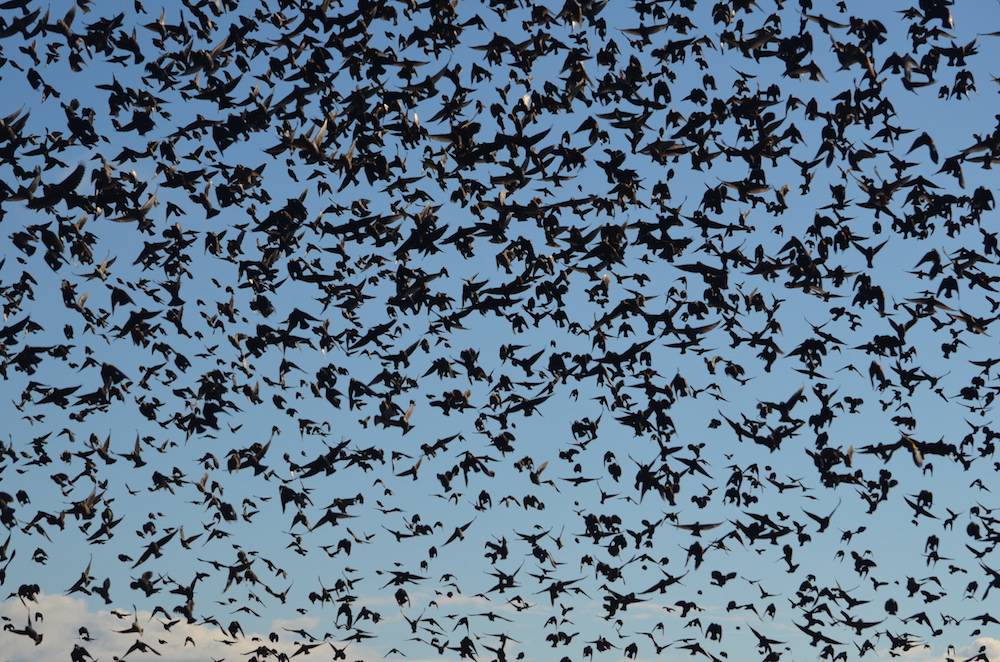May 1902 appears to have been the last time anybody saw a Passenger Pigeon alive in Canada. An even bigger event happened on September 1, 1914 at around 1 o’clock in the afternoon in Cincinnati, Ohio. This was when a zookeeper found Martha, the world’s very last Passenger Pigeon, lying dead at the bottom of her cage. After that, nobody anywhere on the planet would ever see a live Passenger Pigeon again.
September 2014 marks the centennial of that remarkable event.
How did a combination of human greed, technological ingenuity, unsustainable economic forces, naivety, poor scientific knowledge, and a series of biological “flaws” come together to cause the most abundant bird on the planet to become extinct within a scant half-century? At what point does a species become endangered? Is our definition of endangerment adequate? What’s meant by “commercial extinction?” A century later, we’re still learning lessons from the Passenger Pigeon’s sad story.
Doing the Math
Martha’s story is simple enough. Her species went from somewhere around 5 billion birds to zero within 50 years. How was such a thing possible? What’s the math?
What began as a long, slow decline turned into a nosedive when an insatiable demand for wild pigeon meat arose in the 1850’s. The Passenger Pigeon’s population then went into free fall, picking up dizzying speed on its inexorable downward spiral, until it finally crashed.
The last great nesting colony of Passenger Pigeons and the last great slaughter were recorded in 1878 in Missouri. That was when most of the nestlings in a colony of about 20 million adults were killed. A similar fate befell another large colony in Michigan that year. Later that same fall, one of the largest remnant flocks of migrating pigeons was all but wiped out in New York State.
Martha’s final dance with extinction was preceded by two other notable extinction phases. By the mid 1880s, the Passenger Pigeon would’ve been considered “commercially extinct,” much like the Atlantic Cod is today. This came about when there were so few birds left that market hunters gave up and turned their attention elsewhere to make a living.
The second stage in extinction occurred just before Martha’s final expiration date rolled up in 1914. This is when the Passenger Pigeon became “functionally extinct,” a condition that happens when all remaining individuals in a population are either of only one sex or are otherwise no longer capable of breeding. For the Passenger Pigeon, this event arrived in 1910, which is when the last of the other captive pigeons died; leaving Martha perched as the sole survivor.

A female (left) and male (right) Passenger Pigeon. Credit: Photo courtesy of Royal Ontario Museum
When does a Species become Endangered?
We know the exact place and time when the Passenger Pigeon went extinct. But when did the species become endangered?
With the benefit of 20/20 hindsight, it’s easy to look back now and see how Martha could have been regarded as an endangered species even when there were still millions of pigeons flying around. One can maybe even see how Martha’s fate was effectively sealed as soon as the first European colonists landed at Plymouth in the 1620’s. An intractable interplay between two primary forces was set to unfold, and the extinction story had to play itself out.
First, there were two highly-consequential aspects of the human condition: 1) human greed, and 2) the uncanny knack for figuring out ingenious ways of killing large numbers of organisms with great efficiency. Equally important were the biological traits of the Passenger Pigeon itself. In the presence of the aforementioned human ingredients, these biological traits manifested themselves as “fatal flaws.”
The Fatal Flaws
The Passenger Pigeon had at least five fatal flaws. . .
Fatal flaw #1. First of all, this bird wasn’t just super-abundant; it was hyper-abundant. Throughout the entire year, it did everything (roosting, nesting, migrating) in unimaginably enormous flocks. These flocks didn’t just number into the millions or the hundreds of millions. They could sometimes even get into the billions! In a world outside human influence, there’s safety in numbers. Large flocks, herds and schools of animals are designed to overwhelm and confuse the hunting abilities of non-human predators. But when you introduce the technical prowess of humans into the predator equation, large flocks simply become highly attractive targets.
Fatal flaw #2: The Passenger Pigeon laid only one egg each year. This is a really bad idea if you’re a species that needs to compensate for abnormally high rates of adult mortality. Without enough babies coming on stream, you quickly find yourself in a deficit situation, facing a period of negative growth. Extinction is simply the inescapable mathematical consequence of persistent, negative population growth.
Fatal flaw #3: By all accounts, the Passenger Pigeon was not only good eating, it was deee-licious! For a time, pigeon meat seemed to be on almost everyone’s dinner plate. Millions of pigeons began to land on the restaurant menus of big, hungry places like 19th century New York City, Chicago, Philadelphia, Boston, St. Louis, and Toronto. To make matters worse, the young pigeons (the squabs) were even yummier than the adults. Accessing the squabs meant virtually every nesting colony was eventually being disrupted by humans, and breeding failures became increasingly widespread.
Fatal flaw #4: Martha was something of a specialist. For much of the year she had a specialized diet, relying on nuts produced by mature deciduous trees – especially acorns, chestnuts, and beechnuts. Species that specialize on something always have a harder time adapting to change than generalists, especially when the changes come quickly. As ever-increasing numbers of European settlers advanced across the continent, the Passenger Pigeon wasn’t able to find its preferred foods, or favourable nesting areas within the agricultural landscape that was sweeping away the great eastern deciduous forests that the bird was adapted to. Habitat loss was a critical piece of the Passenger Pigeon’s extinction equation.
Fatal flaw #5: Nowadays, we’re apt to look to captive breeding programs in zoos as being the method of last resort for bringing an endangered species back from the brink. Unfortunately, the idea didn’t fly with the Passenger Pigeon. There were still about 120 pigeons held in captivity in various places in the United States in the early 1900s, but they all refused to breed. We’ll never know for sure why, but it is believed that the cascade of reproductive hormones that triggered the Passenger Pigeon’s breeding behaviour could only be released when the birds got together in their large communal flocks. In any case, in her 29 years, Martha never laid a single fertile egg.
The Human Dimension
By the mid 1800s, the human population of North America was starting its exponential growth. Luckily, prodigious quantities of Passenger Pigeons were available to help satisfy the growing hunger for protein. The bird’s downfall began in earnest when the demand for pigeon meat in cities and towns began to be fed by professional “market hunters.” Motivated by profit, these people earned their living by killing as many pigeons as possible. In no time at all, they figured out every conceivable means of killing huge numbers of them.
The commercial market-hunting business became even more efficient in the mid 1800s, with the introduction of the telegraph and the opening of the railroads. The telegraph served as the social media outlet of the day, allowing hunters to communicate amongst themselves, and letting one another know where to find the otherwise unpredictable flocks of nomadic pigeons. The railroads then not only gave the market hunters the means to follow the birds wherever they went, but allowed them to ship uncountable boxcar loads of pigeons to the city markets as well.
Back then, and quite unlike today, there was no means to monitor the size of the pigeon’s population. So, nobody had any real clue just how poorly the species was faring until it was far too late. Nor was there any real inclination to enact laws to protect the bird. Indeed, a childlike belief that the supply of pigeons was inexhaustible was astonishingly widespread.
To give some idea just how numerous the species was, a single flock of migrating birds in Kentucky was estimated to contain over 2 billion birds. Another flock in Mississauga, Ontario was said to be over 3.7 billion birds. As late as 1871, a nesting colony in Wisconsin contained 136 million birds and covered 2 200 square kilometres. The Passenger Pigeon’s incomprehensible migrations reportedly darkened the skies for days on end. This clearly wasn’t just a bird; it was a phenomenon.
The first law that afforded the Passenger Pigeon any kind of protection was enacted in Michigan in 1897. This, of course, arrived far too late to benefit the species. The last nesting in Canada was recorded in 1898. The last hard evidence of a bird in the wild was of one shot by a boy in Ohio on March 24, 1900. In 1910, a reward of $2200 was offered for anyone who could find a nest. No one ever claimed the prize.
The “Lazarus Effect”
The “Lazarus Effect” is a term biologists use to describe what happens when a species that’s declared extinct later comes back to life. So far, this has happened only when a supposedly once-extinct species gets itself rediscovered by somebody who went out and explored a corner of the world that nobody had looked in before. There are over a hundred examples of these kinds of “resurrections” having taken place. For instance, everyone thought that a small seabird called the Bermuda Petrel went extinct in 1620. . . until 18 pairs were discovered in 1951, happily nesting on an uninhabited rocky headland in Bermuda.
More recently, the “Lazarus Effect” is poised to take on the more miraculous, biblical kind of meaning as originally recounted in the New Testament. This is because some clever geneticists are proposing to bring some genuinely-extinct species back from the dead by implanting fragments of their now extinct DNA into living animals. This isn’t just Hollywood science fiction. A team of scientists is hard at work on a project that’s specifically trying to resurrect the Passenger Pigeon. To bring it back from the dead!
What happens if the mad scientists succeed in their de-extinction efforts? Hard to know. Hopefully, no zombie pigeons will ever escape and get outside the safe confines of the lab or zoo. Because if they do, one can only wonder what kinds of havoc the crazed birds might want to wreak on humanity in their quest to avenge Martha.
Epilogue
If nothing else, one would think that Martha’s story would’ve proved, beyond a shadow of a doubt, that a species doesn’t need to be rare to become endangered. One hundred years later, however, it’s still easy to find people who believe that common organisms can’t ever be over-harvested, let alone driven to extinction. Oh sigh.
It’s not surprising that Martha’s demise didn’t make newspaper headlines on September 1, 1914. After all, World War I was just around the corner, and humans were busy preparing to kill one another off in large numbers. All the world’s eyes were understandably focussed elsewhere, not on the misfortune of some poor bird lying dead at the bottom of a cage in Cincinnati, Ohio.
So, Martha quietly dropped dead without any fanfare. None. Remarkably, there aren’t even any photographs of a Passenger Pigeon living in the wild. The only photos in existence are either portraits of caged birds or dead ones.
One hundred years isn’t much more than a human lifetime. To mark the biggest species extermination that’s ever taken place at the hands of man, the memorials are remarkably few. First up was a small, bronze plaque that was initially erected in the Cincinnati Zoological Gardens, near the cage where Martha died. Her body was stuffed and mounted by a taxidermist, and set on display for a while on a dead stick in the Smithsonian Institution in Washington. Later on, the zoo created a more fitting memorial, which is now a national historic site. Elsewhere, there’s a memorial plaque on a cairn in a far away forest in Wisconsin.
Here in Canada, the Royal Ontario Museum (ROM) in Toronto houses the world’s biggest collection of Passenger Pigeons. When I was growing up, the ROM had a small, but captivating diorama that depicted the spring migration of Passenger Pigeons returning to Ontario. Installed in 1935, the display was removed in 1980. However, to mark the 100 years that have passed since Martha’s death, the ROM just reopened a Passenger Pigeon display that replicates the original diorama. Coincidentally, 2014 also marks the centennial of the museum’s own founding.
Despite Martha’s sorry ending, there is a silver lining in the cloud. The extinction wasn’t all for naught. Just two years after Martha kicked the bucket, a new law – the Migratory Bird Treaty – was signed by Canada and the United States in 1916. This treaty outlawed the commercial exploitation of wild birds. It arrived just in the nick of time for dozens of species of waterfowl, herons, terns, and shorebirds that were then teetering on the brink of extinction. Today, most of the species that were facing oblivion 100 years ago have rebounded and are once again doing well. This just serves to show that if you give her half a chance and a bit of a nudge, Mother Nature can be incredibly resilient.
Not too far from where I live, there’s a place called Mimico. It’s on the north shore of Lake Ontario, right next door to Toronto. Its name is derived from the Mississauga word “omiimiikaa” – meaning “abundant with wild pigeons.” Mimico might be a fitting place for a Passenger Pigeon memorial in Canada.
















